Coincident Nodal Line and Nodal Surface Phonon States in Ternary Phosphide Compound BaLiP
Abstract
1. Introduction
2. Computational Methodology
3. Results and Discussions
4. Conclusions
Author Contributions
Funding
Data Availability Statement
Conflicts of Interest
Appendix A
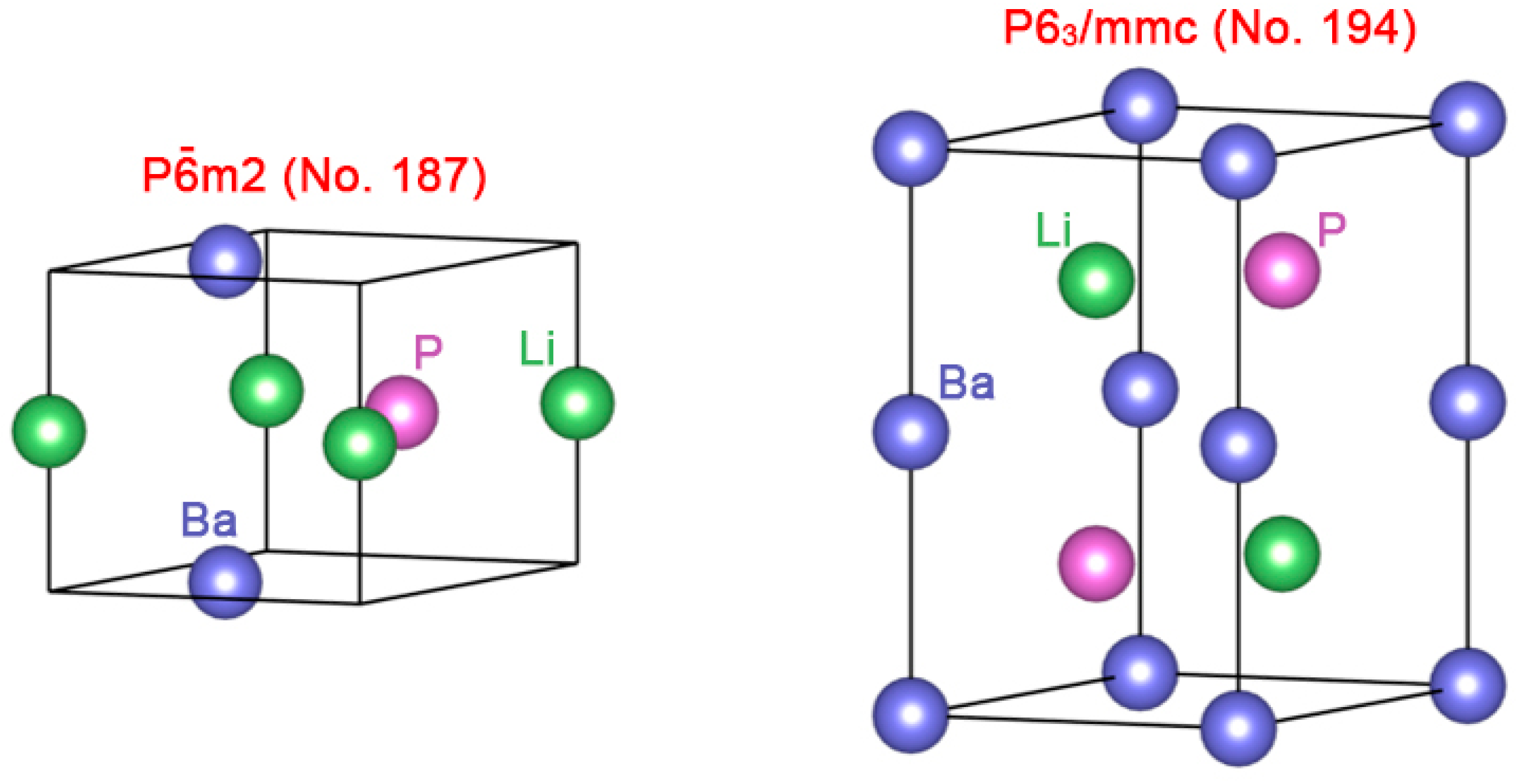

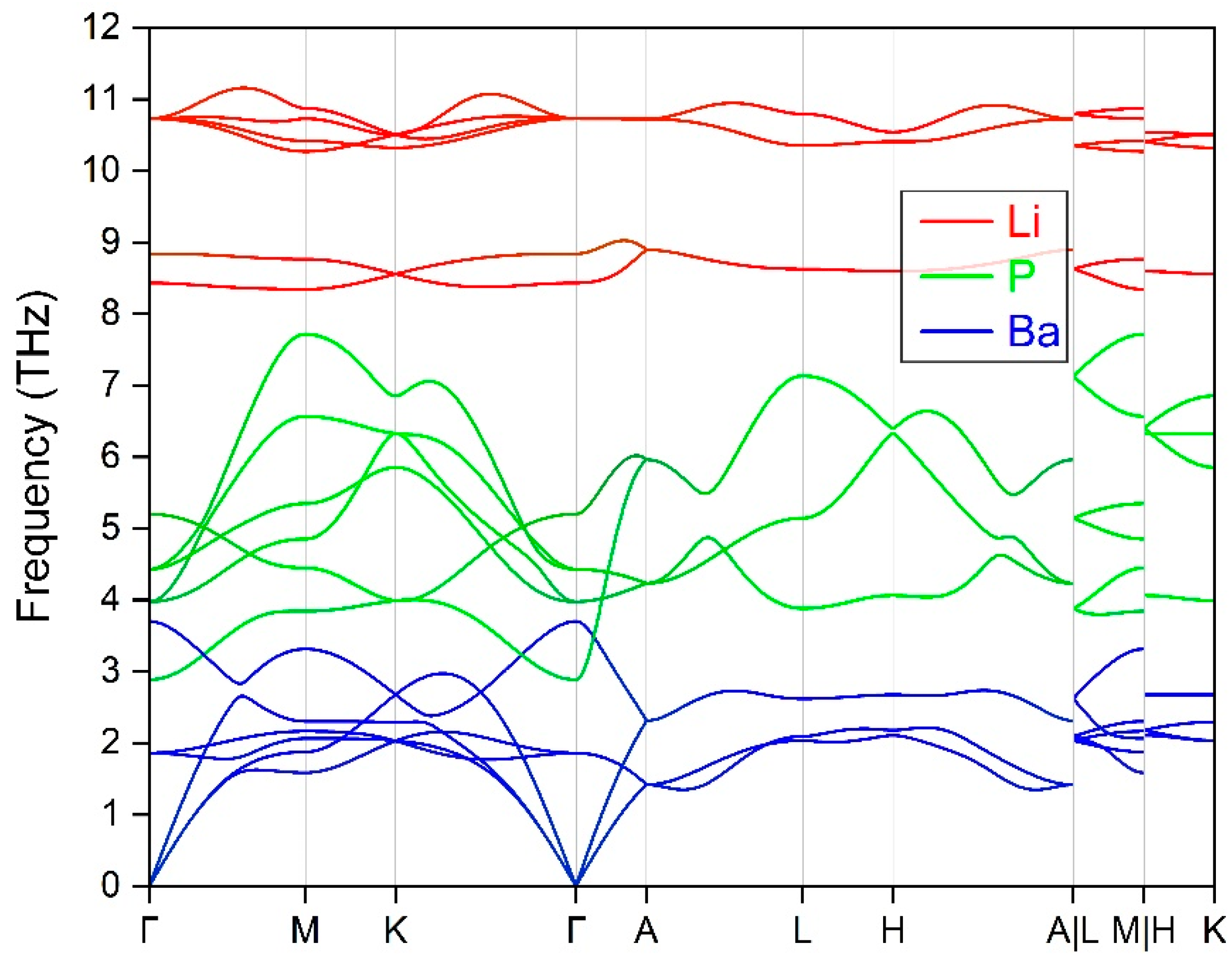

References
- Senthil, T. Symmetry-Protected Topological Phases of Quantum Matter. Annu. Rev. Condens. Matter Phys. 2015, 6, 299–324. [Google Scholar] [CrossRef]
- Yan, B.; Felser, C. Topological Materials: Weyl Semimetals. Annu. Rev. Condens. Matter Phys. 2017, 8, 337–354. [Google Scholar] [CrossRef]
- Gao, H.; Venderbos, J.W.F.; Kim, Y.; Rappe, A.M. Topological Semimetals from First Principles. Annu. Rev. Mater. Res. 2019, 49, 153–183. [Google Scholar] [CrossRef]
- Hasan, M.Z.; Kane, C.L. Colloquium: Topological insulators. Rev. Mod. Phys. 2010, 82, 3045–3067. [Google Scholar] [CrossRef]
- Qi, X.-L.; Zhang, S.-C. Topological insulators and superconductors. Rev. Mod. Phys. 2011, 83, 1057–1110. [Google Scholar] [CrossRef]
- Bansil, A.; Lin, H.; Das, T. Colloquium: Topological band theory. Rev. Mod. Phys. 2016, 88, 021004. [Google Scholar] [CrossRef]
- Chiu, C.-K.; Teo, J.C.Y.; Schnyder, A.P.; Ryu, S. Classification of topological quantum matter with symmetries. Rev. Mod. Phys. 2016, 88, 035005. [Google Scholar] [CrossRef]
- Cooper, N.R.; Dalibard, J.; Spielman, I.B. Topological bands for ultracold atoms. Rev. Mod. Phys. 2019, 91, 015005. [Google Scholar]
- Bernevig, B.A.; Felser, C.; Beidenkopf, H. Progress and prospects in magnetic topological materials. Nature 2022, 603, 41–51. [Google Scholar] [CrossRef] [PubMed]
- Bradlyn, B.; Elcoro, L.; Cano, J.; Vergniory, M.G.; Wang, Z.; Felser, C.; Aroyo, M.I.; Bernevig, B.A. Topological quantum chemistry. Nature 2017, 547, 298–305. [Google Scholar] [CrossRef] [PubMed]
- Vergniory, M.G.; Elcoro, L.; Felser, C.; Regnault, N.; Bernevig, B.A.; Wang, Z. A complete catalogue of high-quality topological materials. Nature 2019, 566, 480–485. [Google Scholar] [CrossRef] [PubMed]
- Zhang, T.; Jiang, Y.; Song, Z.; Huang, H.; He, Y.; Fang, Z.; Weng, H.; Fang, C. Catalogue of topological electronic materials. Nature 2019, 566, 475–479. [Google Scholar] [CrossRef] [PubMed]
- Xu, Y.; Elcoro, L.; Song, Z.-D.; Wieder, B.J.; Vergniory, M.G.; Regnault, N.; Chen, Y.; Felser, C.; Bernevig, B.A. High-throughput calculations of magnetic topological materials. Nature 2020, 586, 702–707. [Google Scholar] [CrossRef] [PubMed]
- Elcoro, L.; Wieder, B.J.; Song, Z.; Xu, Y.; Bradlyn, B.; Bernevig, B.A. Magnetic topological quantum chemistry. Nat. Commun. 2021, 12, 5965. [Google Scholar] [CrossRef] [PubMed]
- Liu, G.-B.; Chu, M.; Zhang, Z.; Yu, Z.-M.; Yao, Y. SpaceGroupIrep: A package for irreducible representations of space group. Comput. Phys. Commun. 2021, 265, 107993. [Google Scholar] [CrossRef]
- Yu, Z.; Zhang, Z.; Liu, G.-B.; Wu, W.; Li, X.-P.; Zhang, R.-W.; Yang, S.; Yao, Y. Encyclopedia of emergent particles in three-dimensional crystals. Sci. Bull. 2021, 67, 375. [Google Scholar] [CrossRef]
- Zhang, Z.; Liu, G.-B.; Yu, Z.-M.; Yang, S.A.; Yao, Y. Encyclopedia of emergent particles in type-IV magnetic space groups. Phys. Rev. B 2022, 105, 104426. [Google Scholar] [CrossRef]
- Gao, J.; Wu, Q.; Persson, C.; Wang, Z. Irvsp: To obtain irreducible representations of electronic states in the VASP. Comput. Phys. Commun. 2021, 261, 107760. [Google Scholar] [CrossRef]
- Zhi, G.-X.; Xu, C.; Wu, S.-Q.; Ning, F.; Cao, C. WannSymm: A symmetry analysis code for Wannier orbitals. Comput. Phys. Commun. 2022, 271, 108196. [Google Scholar] [CrossRef]
- Tang, F.; Po, H.C.; Vishwanath, A.; Wan, X. Comprehensive search for topological materials using symmetry indicators. Nature 2019, 566, 486–489. [Google Scholar] [CrossRef]
- Tang, F.; Po, H.C.; Vishwanath, A.; Wan, X. Efficient topological materials discovery using symmetry indicators. Nat. Phys. 2019, 15, 470–476. [Google Scholar] [CrossRef]
- Po, H.C.; Vishwanath, A.; Watanabe, H. Complete theory of symmetry-based indicators of band topology. Nat. Commun. 2017, 8, 50. [Google Scholar] [CrossRef]
- Chen, X.-Q.; Liu, J.; Li, J. Topological phononic materials: Computation and data. Innovation 2021, 2, 100134. [Google Scholar] [CrossRef] [PubMed]
- Li, J.; Liu, J.; Baronett, S.A.; Liu, M.; Wang, L.; Li, R.; Chen, Y.; Li, D.; Zhu, Q.; Chen, X.-Q. Computation and data driven discovery of topological phononic materials. Nat. Commun. 2021, 12, 1204. [Google Scholar] [CrossRef]
- Cano, J.; Bradlyn, B.; Vergniory, M.G. Multifold nodal points in magnetic materials. Apl Mater. 2019, 7, 101125. [Google Scholar] [CrossRef]
- He, T.; Zhang, X.; Meng, W.; Jin, L.; Dai, X.; Liu, G. Topological nodal lines and nodal points in the antiferromagnetic material β-Fe2PO5. J. Mater. Chem. C 2019, 7, 12657–12663. [Google Scholar] [CrossRef]
- Jin, L.; Zhang, X.; Dai, X.; Liu, H.; Chen, G.; Liu, G. Centrosymmetric Li2NaN: A superior topological electronic material with critical-type triply degenerate nodal points. J. Mater. Chem. C 2019, 7, 1316–1320. [Google Scholar] [CrossRef]
- Zhang, T.-T.; Yu, Z.-M.; Guo, W.; Shi, D.; Zhang, G.; Yao, Y. From Type-II Triply Degenerate Nodal Points and Three-Band Nodal Rings to Type-II Dirac Points in Centrosymmetric Zirconium Oxide. J. Phys. Chem. Lett. 2017, 8, 5792–5797. [Google Scholar] [CrossRef]
- Weng, H.; Fang, C.; Fang, Z.; Dai, X. Topological semimetals with triply degenerate nodal points in theta-phase tantalum nitride. Phys. Rev. B 2016, 93, 241202. [Google Scholar] [CrossRef]
- Wang, J.-T.; Weng, H.; Chen, C. Topological nodal line semimetals in graphene network structures. Adv. Phys. X 2019, 4, 1625724. [Google Scholar] [CrossRef]
- Yang, T.; Gu, Q.; Wang, P.; Wu, Z.; Zhang, Z. Phononic quadratic nodal lines of different types in Li2NaN. Appl. Phys. Lett. 2022, 121, 053102. [Google Scholar] [CrossRef]
- Jin, L.; Zhang, X.; He, T.; Meng, W.; Dai, X.; Liu, G. Ferromagnetic two-dimensional metal-chlorides MCl (M = Sc, Y, and La): Candidates for Weyl nodal line semimetals with small spin-orbit coupling gaps. Appl. Surf. Sci. 2020, 520, 146376. [Google Scholar] [CrossRef]
- Fang, C.; Weng, H.; Dai, X.; Fang, Z. Topological nodal line semimetals. Chin. Phys. B 2016, 25, 117106. [Google Scholar] [CrossRef]
- Jin, L.; Zhang, X.; He, T.; Meng, W.; Dai, X.; Liu, G. Topological nodal line state in superconducting NaAlSi compound. J. Mater. Chem. C 2019, 7, 10694–10699. [Google Scholar] [CrossRef]
- Zhang, X.; Fu, B.; Jin, L.; Dai, X.; Liu, G.; Yao, Y. Topological Nodal Line Electrides: Realization of an Ideal Nodal Line State Nearly Immune from Spin-Orbit Coupling. J. Phys. Chem. C 2019, 123, 25871–25876. [Google Scholar] [CrossRef]
- He, J.; Kong, X.; Wang, W.; Kou, S.-P. Type-II nodal line semimetal. New J. Phys. 2018, 20, 053019. [Google Scholar] [CrossRef]
- Khan, M.R.; Bu, K.; Wang, J.-T. Topological nodal line semimetal in an all-sp2 monoclinic carbon. New J. Phys. 2022, 24, 043007. [Google Scholar] [CrossRef]
- Li, Z.H.; Wang, W.; Zhou, P.; Ma, Z.S.; Sun, L.Z. New type of hybrid nodal line semimetal in Be2Si. New J. Phys. 2019, 21, 033018. [Google Scholar] [CrossRef]
- Yang, T.; Zhang, X. Nearly flat nodal surface states in pseudo-one-dimensional molybdenum monochalcogenides X(MoS)3 (X = K, Rb, and Cs). J. Mater. Chem. C 2020, 8, 9046–9054. [Google Scholar] [CrossRef]
- Khan, M.R.; Bu, K.; Wang, J.-T.; Chen, C. Topological nodal surface semimetal states in Sr5X3 compounds (X = As, Sb, Bi). Phys. Rev. B 2022, 105, 245152. [Google Scholar] [CrossRef]
- Xie, C.; Yuan, H.; Liu, Y.; Wang, X. Two-nodal surface phonons in solid-state materials. Phys. Rev. B 2022, 105, 054307. [Google Scholar] [CrossRef]
- Zhang, X.M.; Yu, Z.M.; Zhu, Z.M.; Wu, W.K.; Wang, S.S.; Sheng, X.L.; Yang, S.A. Nodal loop and nodal surface states in the Ti3Al family of materials. Phys. Rev. B 2018, 97, 235150. [Google Scholar] [CrossRef]
- Fu, B.-B.; Yi, C.-J.; Zhang, T.-T.; Caputo, M.; Ma, J.-Z.; Gao, X.; Lv, B.Q.; Kong, L.-Y.; Huang, Y.-B.; Richard, P.; et al. Dirac nodal surfaces and nodal lines in ZrSiS. Sci. Adv. 2019, 5, eaau6459. [Google Scholar] [CrossRef] [PubMed]
- Xiao, M.; Ye, L.; Qiu, C.; He, H.; Liu, Z.; Fan, S. Experimental demonstration of acoustic semimetal with topologically charged nodal surface. Sci. Adv. 2020, 6, eaav2360. [Google Scholar] [CrossRef] [PubMed]
- Yang, T.; Khenata, R.; Wang, X. Predicted remarkably topological nodal surface states in P63/m type Sr3WN3 from first-principles. Results Phys. 2020, 17, 103026. [Google Scholar] [CrossRef]
- Kang, Q.; Chen, Y.; Shan, P.; Wang, P.; Cui, H.; Yang, T. Quadratic nodal line phonon with hybrid type in hexagonal compound SrCuSi. Results Phys. 2022, 41, 105953. [Google Scholar] [CrossRef]
- Yu, Z.-M.; Wu, W.; Sheng, X.-L.; Zhao, Y.X.; Yang, S.A. Quadratic and cubic nodal lines stabilized by crystalline symmetry. Phys. Rev. B 2019, 99, 121106. [Google Scholar] [CrossRef]
- Zhang, T.; Takahashi, R.; Fang, C.; Murakami, S. Twofold quadruple Weyl nodes in chiral cubic crystals. Phys. Rev. B 2020, 102, 125148. [Google Scholar] [CrossRef]
- Yu, W.C.; Zhou, X.; Chuang, F.-C.; Yang, S.A.; Lin, H.; Bansil, A. Nonsymmorphic cubic Dirac point and crossed nodal rings across the ferroelectric phase transition in LiOsO3. Phys. Rev. Mater. 2018, 2, 051201. [Google Scholar] [CrossRef]
- Liu, Q.; Zunger, A. Predicted Realization of Cubic Dirac Fermion in Quasi-One-Dimensional Transition-Metal Monochalcogenides. Phys. Rev. X 2017, 7, 021019. [Google Scholar] [CrossRef]
- Jia, S.; Xu, S.-Y.; Hasan, M.Z. Weyl semimetals, Fermi arcs and chiral anomalies. Nat. Mater. 2016, 15, 1140–1144. [Google Scholar] [CrossRef] [PubMed]
- Ma, Q.; Xu, S.-Y.; Chan, C.-K.; Zhang, C.-L.; Chang, G.; Lin, Y.; Xie, W.; Palacios, T.; Lin, H.; Jia, S.; et al. Direct optical detection of Weyl fermion chirality in a topological semimetal. Nat. Phys. 2017, 13, 842–847. [Google Scholar] [CrossRef]
- Xu, S.-Y.; Alidoust, N.; Belopolski, I.; Yuan, Z.; Bian, G.; Chang, T.-R.; Zheng, H.; Strocov, V.N.; Sanchez, D.S.; Chang, G.; et al. Discovery of a Weyl fermion state with Fermi arcs in niobium arsenide. Nat. Phys. 2015, 11, 748–754. [Google Scholar] [CrossRef]
- Yang, L.X.; Liu, Z.K.; Sun, Y.; Peng, H.; Yang, H.F.; Zhang, T.; Zhou, B.; Zhang, Y.; Guo, Y.F.; Rahn, M.; et al. Weyl semimetal phase in the non-centrosymmetric compound TaAs. Nat. Phys. 2015, 11, 728–732. [Google Scholar] [CrossRef]
- Manna, K.; Sun, Y.; Muechler, L.; Kubler, J.; Felser, C. Heusler, Weyl and Berry. Nat. Rev. Mater. 2018, 3, 244–256. [Google Scholar] [CrossRef]
- Winkler, G.W.; Singh, S.; Soluyanov, A.A. Topology of triple-point metals. Chin. Phys B 2019, 28, 077303. [Google Scholar] [CrossRef]
- Cai, J.; Xie, Y.; Chang, P.-Y.; Kim, H.-S.; Chen, Y. Nodal-chain network, intersecting nodal rings and triple points coexisting in nonsymmorphic Ba3Si4. Phys. Chem. Chem. Phys. 2018, 20, 21177–21183. [Google Scholar] [CrossRef]
- Barman, C.K.; Mondal, C.; Pathak, B.; Alam, A. Quaternary Heusler alloy: An ideal platform to realize triple point fermions. Phys. Rev. B 2019, 99, 045144. [Google Scholar] [CrossRef]
- Yang, H.; Yu, J.; Parkin, S.S.P.; Felser, C.; Liu, C.-X.; Yan, B. Prediction of Triple Point Fermions in Simple Half-Heusler Topological Insulators. Phys. Rev. Lett. 2017, 119, 136401. [Google Scholar] [CrossRef]
- Singh, S.; Wu, Q.; Yue, C.; Romero, A.H.; Soluyanov, A.A. Topological phonons and thermoelectricity in triple-point metals. Phys. Rev. Mater. 2018, 2, 114204. [Google Scholar] [CrossRef]
- Zhu, Z.; Winkler, G.W.; Wu, Q.; Li, J.; Soluyanov, A.A. Triple Point Topological Metals. Phys. Rev. X 2016, 6, 031003. [Google Scholar] [CrossRef]
- Wehling, T.O.; Black-Schaffer, A.M.; Balatsky, A.V. Dirac materials. Adv. Phys. 2014, 63, 1–76. [Google Scholar] [CrossRef]
- Pal, P.B. Dirac, Majorana, and Weyl fermions. Am. J. Phys. 2011, 79, 485–498. [Google Scholar] [CrossRef]
- Vafek, O.; Vishwanath, A. Dirac Fermions in Solids: From High-T-c Cuprates and Graphene to Topological Insulators and Weyl Semimetals. Annu. Rev. Condens. Matter Phys. 2014, 5, 83–112. [Google Scholar] [CrossRef]
- Xie, L.S.; Schoop, L.M.; Seibel, E.M.; Gibson, Q.D.; Xie, W.; Cava, R.J. A new form of Ca3P2 with a ring of Dirac nodes. Apl Mater. 2015, 3, 083602. [Google Scholar] [CrossRef]
- Zhang, H.; Meng, W.; Liu, Y.; Zhang, X.; Gao, J.; Dai, X.; Liu, G. Theoretical study of compounds XSb (X = La, Pr, Nd): Realization of inner nodal chains, nodal line frame, and Dirac points. Comput. Mater. Sci. 2022, 206, 111231. [Google Scholar] [CrossRef]
- Okamoto, Y.; Inohara, T.; Yamakage, A.; Yamakawa, Y.; Takenaka, K. Low Carrier Density Metal Realized in Candidate Line-Node Dirac Semimetals CaAgP and CaAgAs. J. Phys. Soc. Jpn. 2016, 85, 123701. [Google Scholar] [CrossRef]
- Yamakage, A.; Yamakawa, Y.; Tanaka, Y.; Okamoto, Y. Line-Node Dirac Semimetal and Topological Insulating Phase in Noncentrosymmetric Pnictides CaAgX (X = P, As). J. Phys. Soc. Jpn. 2016, 85, 013708. [Google Scholar] [CrossRef]
- Yang, T.Y.; Wan, Q.; Yan, D.Y.; Zhu, Z.; Wang, Z.W.; Peng, C.; Huang, Y.B.; Yu, R.; Hu, J.; Mao, Z.Q.; et al. Directional massless Dirac fermions in a layered van der Waals material with one-dimensional long-range order. Nat. Mater. 2019, 19, 27–33. [Google Scholar] [CrossRef]
- Tang, P.; Zhou, Q.; Xu, G.; Zhang, S.-C. Dirac fermions in an antiferromagnetic semimetal. Nat. Phys. 2016, 12, 1100–1104. [Google Scholar] [CrossRef]
- Lu, Y.; Zhou, D.; Chang, G.; Guan, S.; Chen, W.; Jiang, Y.; Jiang, J.; Wang, X.-s.; Yang, S.A.; Feng, Y.P.; et al. Multiple unpinned Dirac points in group-Va single-layers with phosphorene structure. Npj Comput. Mater. 2016, 2, 16011. [Google Scholar] [CrossRef]
- Du, Y.; Tang, F.; Wang, D.; Sheng, L.; Kan, E.-j.; Duan, C.-G.; Savrasov, S.Y.; Wan, X. CaTe: A new topological node-line and Dirac semimetal. Npj Quantum Mater. 2017, 2, 3. [Google Scholar] [CrossRef]
- Kumar, N.; Yao, M.; Nayak, J.; Vergniory, M.G.; Bannies, J.; Wang, Z.; Schroeter, N.B.M.; Strocov, V.N.; Muechler, L.; Shi, W.; et al. Signatures of Sixfold Degenerate Exotic Fermions in a Superconducting Metal PdSb2. Adv. Mater. 2020, 32, e1906046. [Google Scholar] [CrossRef] [PubMed]
- Chapai, R.; Jia, Y.; Shelton, W.A.; Nepal, R.; Saghayezhian, M.; DiTusa, J.F.; Plummer, E.W.; Jin, C.; Jin, R. Fermions and bosons in nonsymmorphic PdSb2 with sixfold degeneracy. Phys. Rev. B 2019, 99, 161110. [Google Scholar] [CrossRef]
- Jin, L.; Liu, Y.; Zhang, X.; Dai, X.; Liu, G. Sixfold, fourfold, and threefold excitations in the rare-earth metal carbide R2C3. Phys. Rev. B 2021, 104, 045111. [Google Scholar] [CrossRef]
- Sun, Z.P.; Hua, C.Q.; Liu, X.L.; Liu, Z.T.; Ye, M.; Qiao, S.; Liu, Z.H.; Liu, J.S.; Guo, Y.F.; Lu, Y.H.; et al. Direct observation of sixfold exotic fermions in the pyrite-structured topological semimetal PdSb2. Phys. Rev. B 2020, 101, 155114. [Google Scholar] [CrossRef]
- Zhong, M.; Liu, Y.; Zhou, F.; Kuang, M.; Yang, T.; Wang, X.; Zhang, G. Coexistence of phononic sixfold, fourfold, and threefold excitations in the ternary antimonide Zr3Ni3Sb4. Phys. Rev. B 2021, 104, 085118. [Google Scholar] [CrossRef]
- Nie, S.; Bernevig, B.A.; Wang, Z. Sixfold excitations in electrides. Phys. Rev. Res. 2021, 3, L012028. [Google Scholar] [CrossRef]
- Huang, H.; Jin, K.-H.; Liu, F. Black-hole horizon in the Dirac semimetal Zn2In2S5. Phys. Rev. B 2018, 98, 121110. [Google Scholar] [CrossRef]
- Chang, T.-R.; Pletikosic, I.; Kong, T.; Bian, G.; Huang, A.; Denlinger, J.; Kushwaha, S.K.; Sinkovic, B.; Jeng, H.-T.; Valla, T.; et al. Realization of a Type-II Nodal-Line Semimetal in Mg3Bi2. Adv. Sci. 2019, 6, 1800897. [Google Scholar] [CrossRef]
- Zhang, X.; Jin, L.; Dai, X.; Liu, G. Highly anisotropic type-II nodal line state in pure titanium metal. Appl. Phys. Lett. 2018, 112, 122403. [Google Scholar] [CrossRef]
- Zhang, X.; Jin, L.; Dai, X.; Liu, G. Topological Type-II Nodal Line Semimetal and Dirac Semimetal State in Stable Kagome Compound Mg3Bi2. J. Phys. Chem. Lett. 2017, 8, 4814–4819. [Google Scholar] [CrossRef] [PubMed]
- Soluyanov, A.A.; Gresch, D.; Wang, Z.; Wu, Q.; Troyer, M.; Dai, X.; Bernevig, B.A. Type-II Weyl semimetals. Nature 2015, 527, 495–498. [Google Scholar] [CrossRef] [PubMed]
- Li, P.; Wen, Y.; He, X.; Zhang, Q.; Xia, C.; Yu, Z.-M.; Yang, S.A.; Zhu, Z.; Alshareef, H.N.; Zhang, X.-X. Evidence for topological type-II Weyl semimetal WTe2. Nat. Commun. 2017, 8, 2150. [Google Scholar] [CrossRef] [PubMed]
- Li, S.; Yu, Z.-M.; Liu, Y.; Guan, S.; Wang, S.-S.; Zhang, X.; Yao, Y.; Yang, S.A. Type-II nodal loops: Theory and material realization. Phys. Rev. B 2017, 96, 081106. [Google Scholar] [CrossRef]
- Li, X.-P.; Deng, K.; Fu, B.; Li, Y.; Ma, D.-S.; Han, J.; Zhou, J.; Zhou, S.; Yao, Y. Type-III Weyl semimetals: (TaSe4)2I. Phys. Rev. B 2021, 103, L081402. [Google Scholar] [CrossRef]
- Zheng, B.; Xia, B.; Wang, R.; Chen, Z.; Zhao, J.; Zhao, Y.; Xu, H. Ideal type-III nodal-ring phonons. Phys. Rev. B 2020, 101, 100303. [Google Scholar] [CrossRef]
- Yang, T.; Cheng, Z.; Wang, X.; Wang, X.-L. Nodal ring spin gapless semiconductor: New member of spintronic materials. J. Adv. Res. 2021, 28, 43–49. [Google Scholar] [CrossRef]
- Yang, T.; Ding, G.; Cheng, Z.; Wang, X.; Zhang, G. Diverse topological states in a ternary NdAsPd compound. J. Mater. Chem. C 2020, 8, 7741–7748. [Google Scholar] [CrossRef]
- Yang, T.; Ding, S.; Liu, Y.; Wu, Z.; Zhang, G. An ideal Weyl nodal ring with a large drumhead surface state in the orthorhombic compound TiS2. Phys. Chem. Chem. Phys. 2022, 24, 8208–8216. [Google Scholar] [CrossRef]
- Yang, T.; Jin, L.; Liu, Y.; Zhang, X.; Wang, X. Spin-polarized type-II nodal loop and nodal surface states in hexagonal compounds XTiO2 (X = Li, Na, K, Rb). Phys. Rev. B 2021, 103, 235140. [Google Scholar] [CrossRef]
- Yang, T.; Liu, Y.; Wu, Z.; Wang, X.; Zhang, G. Coexistence of different dimensional topological states in stable ternary compound PrSbPt. Mater. Today Phys. 2021, 18, 100348. [Google Scholar] [CrossRef]
- Liu, Q.-B.; Fu, H.-H.; Wu, R. Topological phononic nodal hexahedron net and nodal links in the high-pressure phase of the semiconductor CuCl. Phys. Rev. B 2021, 104, 045409. [Google Scholar] [CrossRef]
- Yan, Z.; Bi, R.; Shen, H.; Lu, L.; Zhang, S.-C.; Wang, Z. Nodal-link semimetals. Phys. Rev. B 2017, 96, 041103. [Google Scholar] [CrossRef]
- Ahn, J.; Kim, D.; Kim, Y.; Yang, B.-J. Band Topology and Linking Structure of Nodal Line Semimetals with Z(2) Monopole Charges. Phys. Rev. Lett. 2018, 121, 106403. [Google Scholar] [CrossRef]
- Chang, G.; Xu, S.-Y.; Zhou, X.; Huang, S.-M.; Singh, B.; Wang, B.; Belopolski, I.; Yin, J.; Zhang, S.; Bansil, A.; et al. Topological Hopf and Chain Link Semimetal States and Their Application to Co2MnGa. Phys. Rev. Lett. 2017, 119, 156401. [Google Scholar] [CrossRef]
- Shao, D.-F.; Zhang, S.-H.; Dang, X.; Tsymbal, E.Y. Tunable two-dimensional Dirac nodal nets. Phys. Rev. B 2018, 98, 161104. [Google Scholar] [CrossRef]
- Zhang, H.; Zhang, X.; He, T.; Dai, X.; Liu, Y.; Liu, G.; Wang, L.; Zhang, Y. Three-dimensional Weyl hourglass networks in the nonsymmorphic half-metal Mg2VO4. Phys. Rev. B 2020, 102, 155116. [Google Scholar] [CrossRef]
- Wang, J.; Yuan, H.; Yu, Z.-M.; Zhang, Z.; Wang, X. Coexistence of symmetry-enforced phononic Dirac nodal-line net and three-nodal surfaces phonons in solid-state materials: Theory and materials realization. Phys. Rev. Mater. 2021, 5, 124203. [Google Scholar] [CrossRef]
- Chen, C.; Su, Z.; Zhang, X.; Chen, Z.; Sheng, X.-L. From Multiple Nodal Chain to Dirac/Weyl Semimetal and Topological Insulator in Ternary Hexagonal Materials. J. Phys. Chem. C 2017, 121, 28587–28593. [Google Scholar] [CrossRef]
- Yu, R.; Wu, Q.; Fang, Z.; Weng, H. From Nodal Chain Semimetal to Weyl Semimetal in HfC. Phys. Rev. Lett. 2017, 119, 036401. [Google Scholar] [CrossRef] [PubMed]
- Gao, Y.; Xie, Y.; Chen, Y.; Gu, J.; Chen, Z. Spindle nodal chain in three-dimensional α′ boron. Phys. Chem. Chem. Phys. 2018, 20, 23500–23506. [Google Scholar] [CrossRef] [PubMed]
- Yan, Q.; Liu, R.; Yan, Z.; Liu, B.; Chen, H.; Wang, Z.; Lu, L. Experimental discovery of nodal chains. Nat. Phys. 2018, 14, 461–464. [Google Scholar] [CrossRef]
- Yi, C.J.; Lv, B.Q.; Wu, Q.S.; Fu, B.B.; Gao, X.; Yang, M.; Peng, X.L.; Li, M.; Huang, Y.B.; Richard, P.; et al. Observation of a nodal chain with Dirac surface states in TiB2. Phys. Rev. B 2018, 97, 201107. [Google Scholar] [CrossRef]
- Bi, R.; Yan, Z.; Lu, L.; Wang, Z. Nodal-knot semimetals. Phys. Rev. B 2017, 96, 201305. [Google Scholar] [CrossRef]
- Sheng, X.-L.; Yu, Z.-M.; Yu, R.; Weng, H.; Yang, S.A. d Orbital Topological Insulator and Semimetal in the Antifluorite Cu2S Family: Contrasting Spin Helicities, Nodal Box, and Hybrid Surface States. J. Phys. Chem. Lett. 2017, 8, 3506–3511. [Google Scholar] [CrossRef]
- Zhou, F.; Chen, H.; Yu, Z.-M.; Zhang, Z.; Wang, X. Realistic cesium fluogermanate: An ideal platform to realize the topologically nodal-box and nodal-chain phonons. Phys. Rev. B 2021, 104, 214310. [Google Scholar]
- Wang, J.; Liu, Y.; Jin, K.-H.; Sui, X.; Zhang, L.; Duan, W.; Liu, F.; Huang, B. Pseudo Dirac nodal sphere semimetal. Phys. Rev. B 2018, 98, 201112. [Google Scholar] [CrossRef]
- Wang, M.; Wang, Y.; Yang, Z.; Fan, J.; Zheng, B.; Wang, R.; Wu, X. Symmetry-enforced nodal cage phonons in Th2BC2. Phys. Rev. B 2022, 105, 174309. [Google Scholar] [CrossRef]
- Ding, G.; Sun, T.; Wang, X. Ideal nodal-net, nodal-chain, and nodal-cage phonons in some realistic materials. Phys. Chem. Chem. Phys. 2022, 24, 11175–11182. [Google Scholar] [CrossRef]
- Zheng, B.; Zhan, F.; Wu, X.; Wang, R.; Fan, J. Hourglass phonons jointly protected by symmorphic and nonsymmorphic symmetries. Phys. Rev. B 2021, 104, L060301. [Google Scholar] [CrossRef]
- Liu, Y.; Xu, Y.; Duan, W. Berry phase and topological effects of phonons. Natl. Sci. Rev. 2018, 5, 314–316. [Google Scholar] [CrossRef]
- Mousavi, S.H.; Khanikaev, A.B.; Wang, Z. Topologically protected elastic waves in phononic metamaterials. Nat. Commun. 2015, 6, 8682. [Google Scholar] [CrossRef] [PubMed]
- Liu, Q.-B.; Qian, Y.; Fu, H.-H.; Wang, Z. Symmetry-enforced Weyl phonons. Npj Comput. Mater. 2020, 6, 95. [Google Scholar] [CrossRef]
- Süsstrunk, R.; Huber, S.D. Classification of topological phonons in linear mechanical metamaterials. Proc. Natl. Acad. Sci. USA 2016, 113, E4767–E4775. [Google Scholar] [CrossRef]
- Süsstrunk, R.; Huber, S.D. Observation of phononic helical edge states in a mechanical topological insulator. Science 2015, 349, 47–50. [Google Scholar] [CrossRef]
- Peng, B.; Hu, Y.; Murakami, S.; Zhang, T.; Monserrat, B. Topological phonons in oxide perovskites controlled by light. Sci. Adv. 2020, 6, eabd1618. [Google Scholar] [CrossRef]
- Zhang, L.; Niu, Q. Chiral Phonons at High-Symmetry Points in Monolayer Hexagonal Lattices. Phys. Rev. Lett. 2015, 115, 115502. [Google Scholar] [CrossRef]
- Liu, Y.; Chen, X.; Xu, Y. Topological Phononics: From Fundamental Models to Real Materials. Adv. Funct. Mater. 2020, 30, 1904784. [Google Scholar] [CrossRef]
- Wang, J.; Yuan, H.; Liu, Y.; Zhou, F.; Wang, X.; Zhang, G. Hourglass Weyl and Dirac nodal line phonons, and drumhead-like and torus phonon surface states in orthorhombic-type KCuS. Phys. Chem. Chem. Phys. 2022, 24, 2752–2757. [Google Scholar] [CrossRef]
- Zhou, F.; Liu, Y.; Wang, J.; Kuang, M.; Yang, T.; Chen, H.; Wang, X.; Cheng, Z. Intersecting topological nodal ring and nodal wall states in superhard superconductor FeB4. Phys. Rev. Mater. 2021, 5, 074201. [Google Scholar] [CrossRef]
- Hafner, J. Ab-initio simulations of materials using VASP: Density-functional theory and beyond. J. Comput. Chem. 2008, 29, 2044–2078. [Google Scholar] [CrossRef] [PubMed]
- Payne, M.C.; Teter, M.P.; Allan, D.C.; Arias, T.A.; Joannopoulos, J.D. Iterative minimization techniques forab initiototal-energy calculations: Molecular dynamics and conjugate gradients. Rev. Mod. Phys. 1992, 64, 1045–1097. [Google Scholar] [CrossRef]
- Blöchl, P.E. Projector augmented-wave method. Phys. Rev. B 1994, 50, 17953–17979. [Google Scholar] [CrossRef] [PubMed]
- Perdew, J.P.; Burke, K.; Ernzerhof, M. Generalized Gradient Approximation Made Simple. Phys. Rev. Lett. 1996, 77, 3865–3868. [Google Scholar] [CrossRef] [PubMed]
- Perdew, J.P.; Ruzsinszky, A.; Csonka, G.I.; Vydrov, O.A.; Scuseria, G.E.; Constantin, L.A.; Zhou, X.; Burke, K. Restoring the Density-Gradient Expansion for Exchange in Solids and Surfaces. Phys. Rev. Lett. 2008, 100, 136406. [Google Scholar] [CrossRef]
- Gonze, X.; Lee, C. Dynamical matrices, Born effective charges, dielectric permittivity tensors, and interatomic force constants from density-functional perturbation theory. Phys. Rev. B 1997, 55, 10355–10368. [Google Scholar] [CrossRef]
- Giannozzi, P.; de Gironcoli, S.; Pavone, P.; Baroni, S. Ab initio calculation of phonon dispersions in semiconductors. Phys. Rev. B 1991, 43, 7231–7242. [Google Scholar] [CrossRef]
- Togo, A.; Tanaka, I. First principles phonon calculations in materials science. Scr. Mater. 2015, 108, 1–5. [Google Scholar] [CrossRef]
- Wu, Q.; Zhang, S.; Song, H.-F.; Troyer, M.; Soluyanov, A.A. WannierTools: An open-source software package for novel topological materials. Comput. Phys. Commun. 2018, 224, 405–416. [Google Scholar] [CrossRef]
- Dong, Y.; DiSalvo, F.J. Synthesis and single crystal structures of ternary phosphides Li4SrP2 and AAeP (A = Li, Na; Ae = Sr, Ba). J. Solid State Chem. 2007, 180, 432–439. [Google Scholar] [CrossRef]
- Hinuma, Y.; Pizzi, G.; Kumagai, Y.; Oba, F.; Tanaka, I. Band structure diagram paths based on crystallography. Comput. Mater. Sci. 2017, 128, 140–184. [Google Scholar] [CrossRef]
- Wang, J.; Li, J.; Yip, S.; Phillpot, S.; Wolf, D. Mechanical instabilities of homogeneous crystals. Phys. Rev. B Condens Matter 1995, 52, 12627–12635. [Google Scholar] [CrossRef] [PubMed]
- Yip, S.; Li, J.; Tang, M.J.; Wang, J.G. Mechanistic aspects and atomic-level consequences of elastic instabilities in homogeneous crystals. Mater. Sci. Eng. A 2001, 317, 236–240. [Google Scholar] [CrossRef]
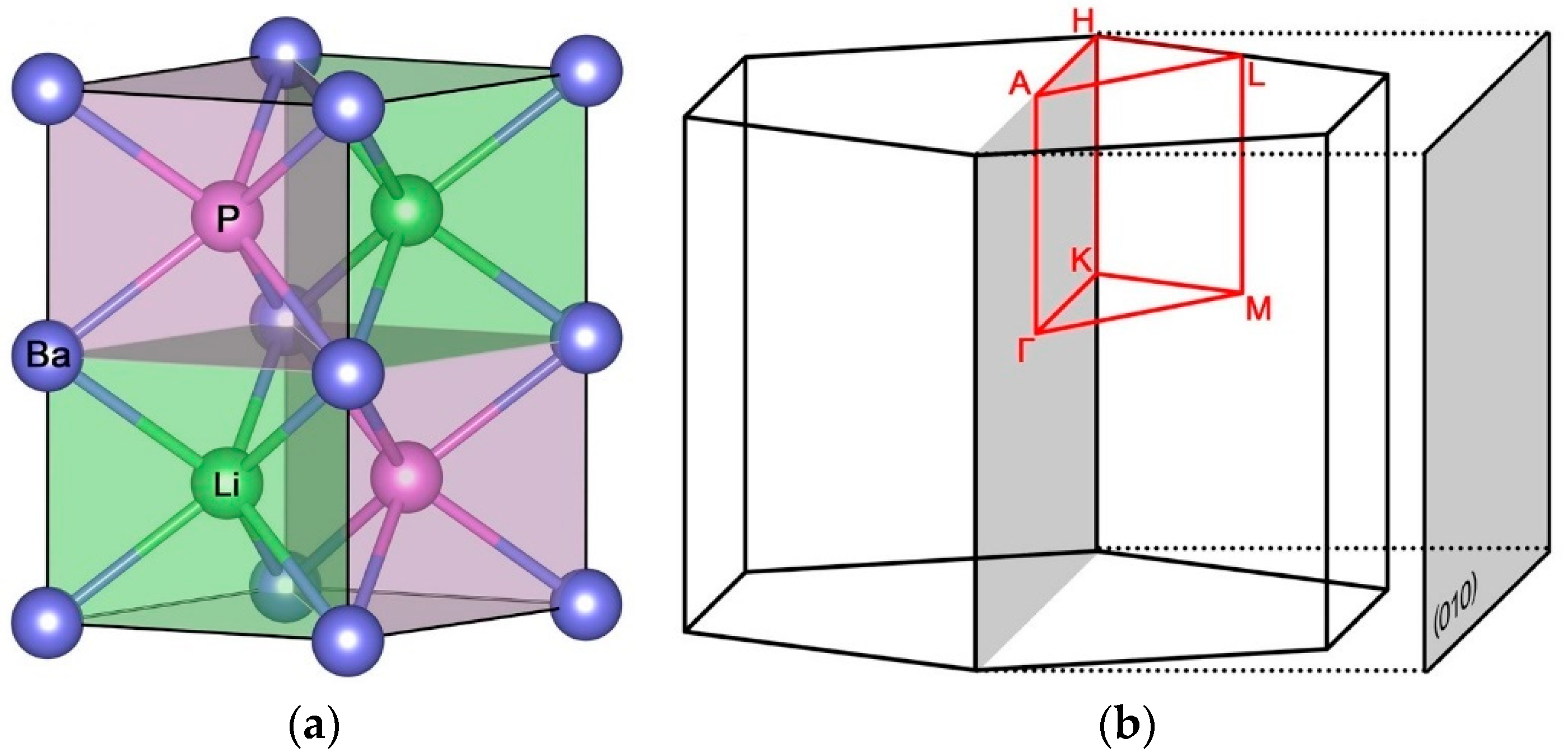
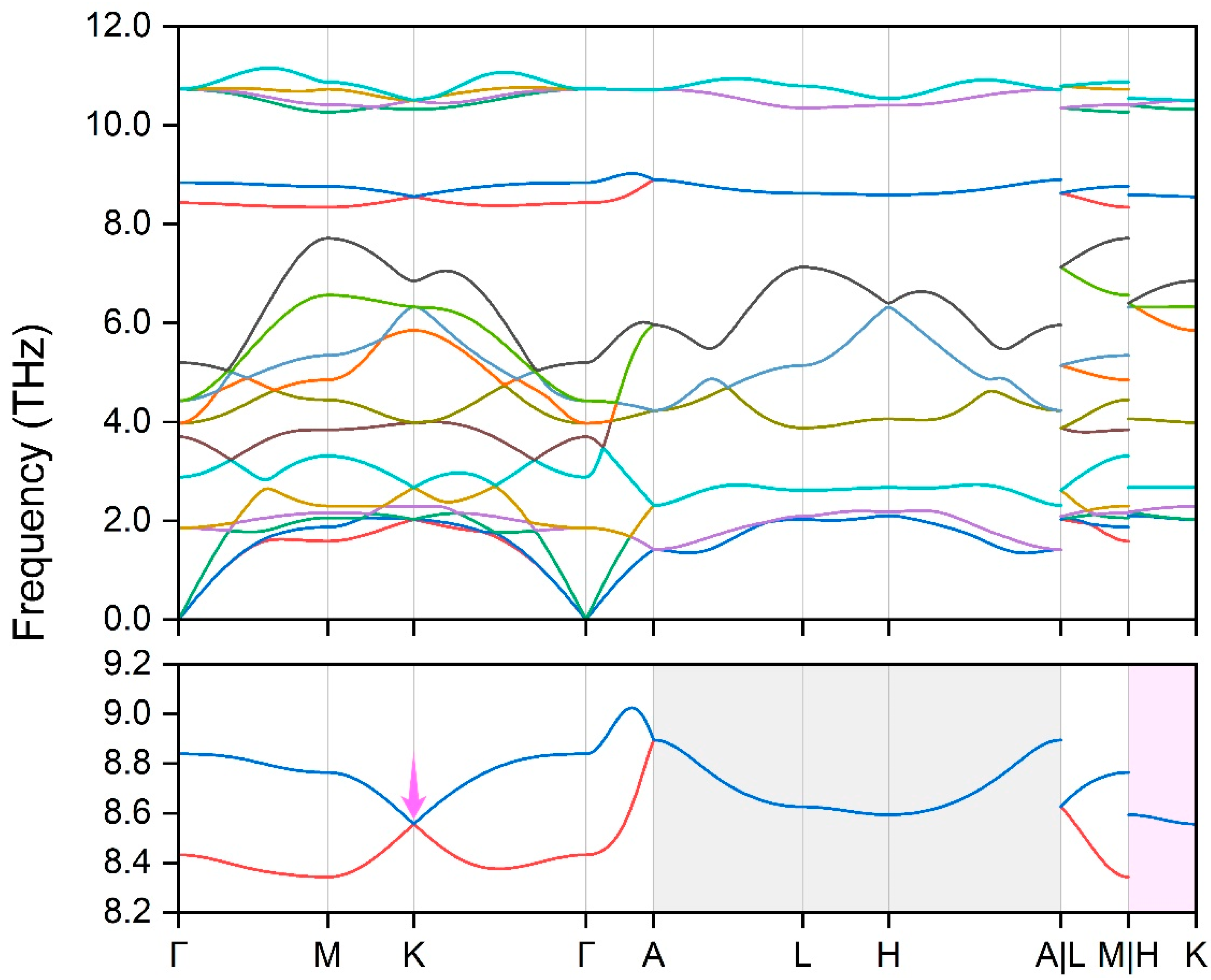
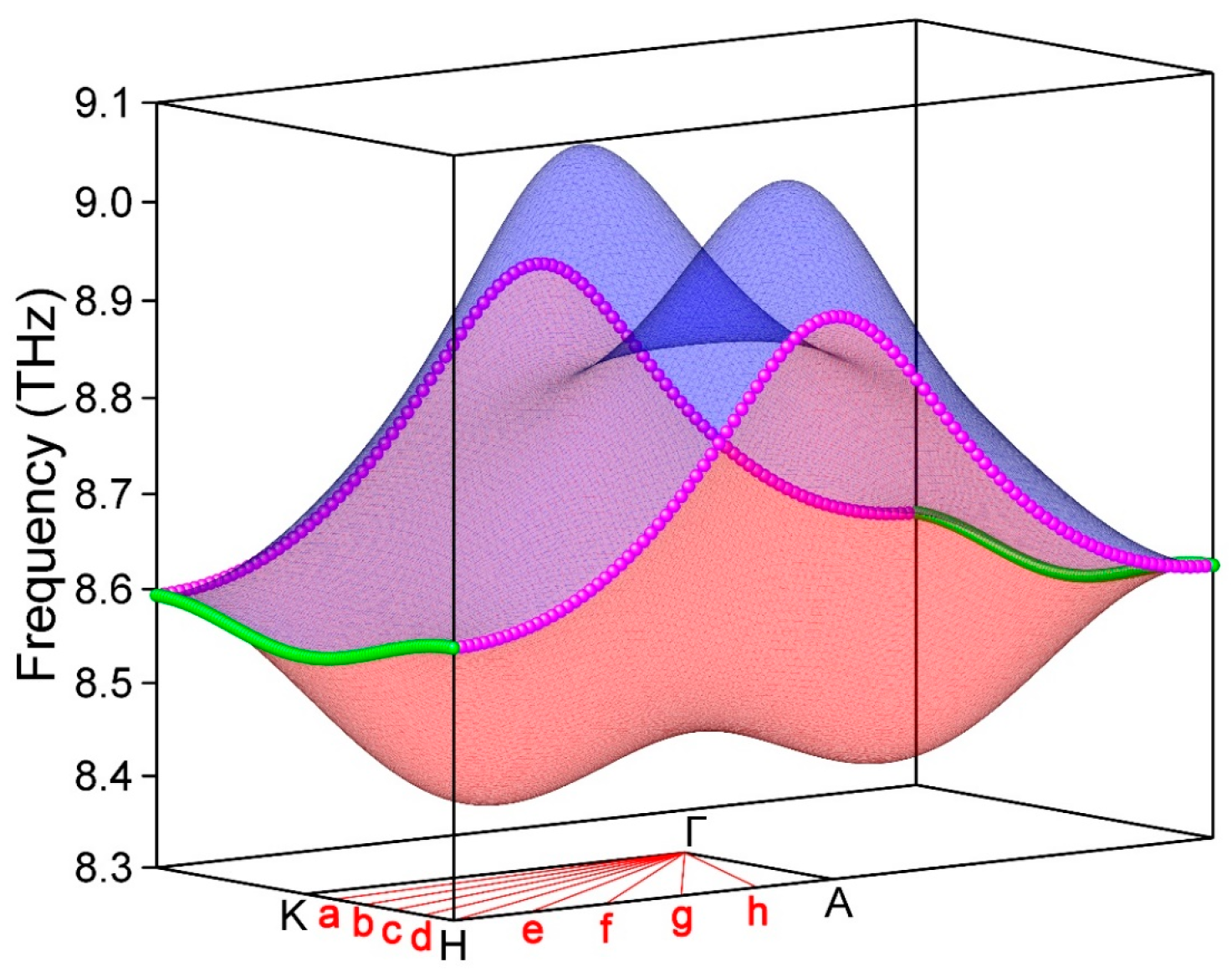
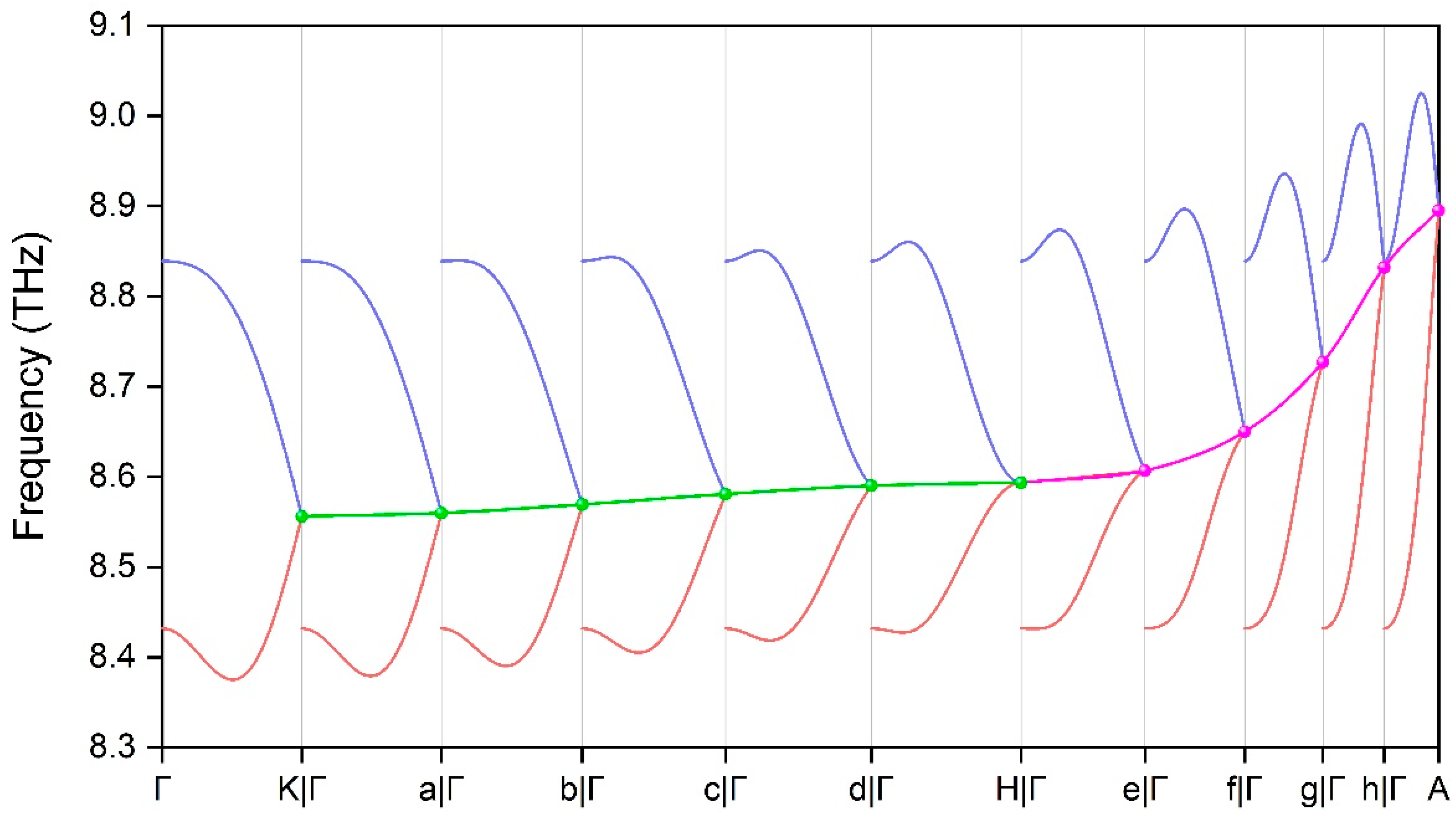
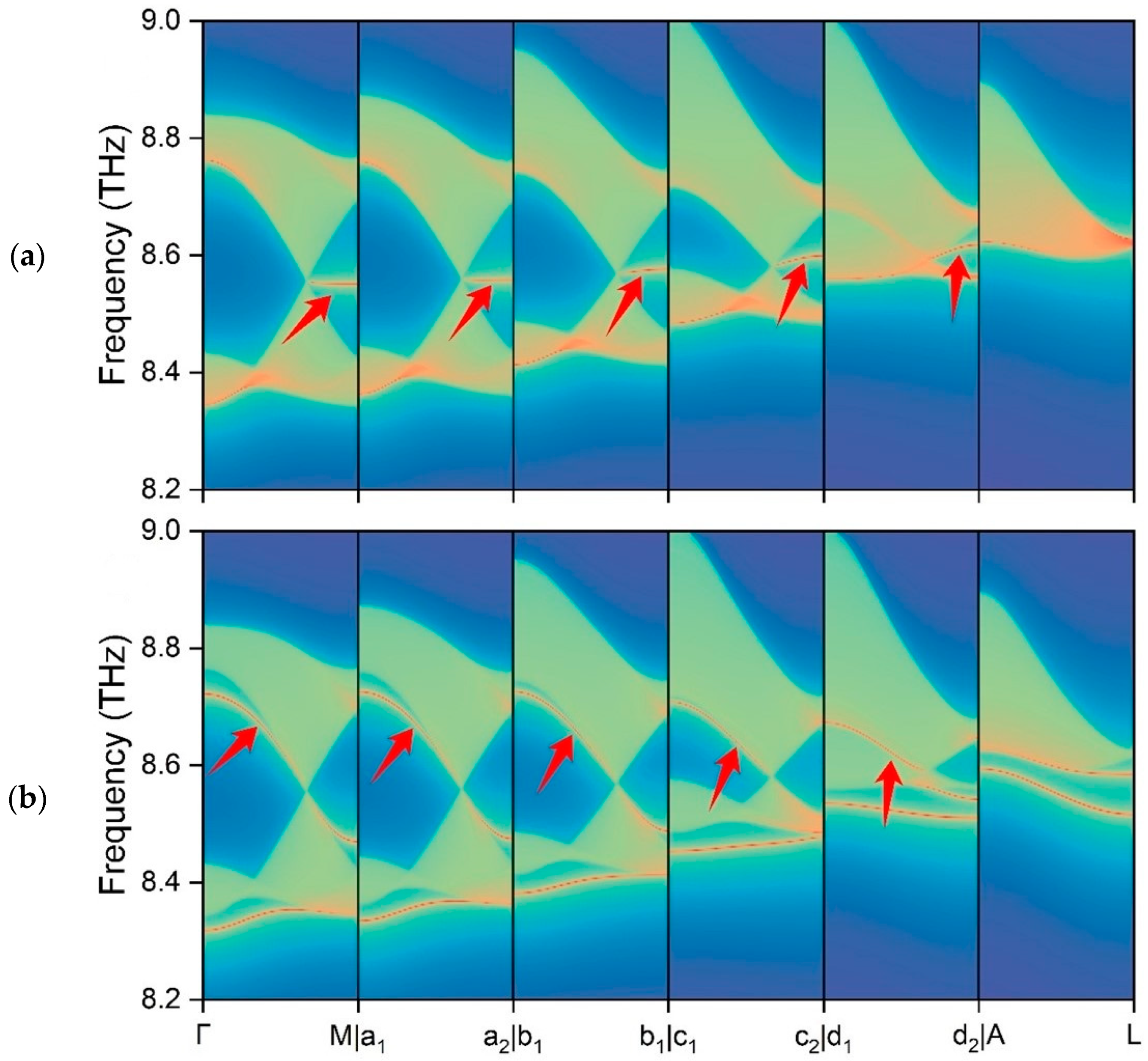

| C11 | C12 | C13 | C33 | C44 | E | G | υ |
|---|---|---|---|---|---|---|---|
| 99.85 | 22.88 | 33.10 | 65.30 | 38.488 | 79.80 | 32.52 | 0.227 |
Publisher’s Note: MDPI stays neutral with regard to jurisdictional claims in published maps and institutional affiliations. |
© 2022 by the authors. Licensee MDPI, Basel, Switzerland. This article is an open access article distributed under the terms and conditions of the Creative Commons Attribution (CC BY) license (https://creativecommons.org/licenses/by/4.0/).
Share and Cite
Cui, H.; Chen, Y.; Kang, Q.; Shan, P.; Yang, T.; Wang, P. Coincident Nodal Line and Nodal Surface Phonon States in Ternary Phosphide Compound BaLiP. Crystals 2022, 12, 1478. https://doi.org/10.3390/cryst12101478
Cui H, Chen Y, Kang Q, Shan P, Yang T, Wang P. Coincident Nodal Line and Nodal Surface Phonon States in Ternary Phosphide Compound BaLiP. Crystals. 2022; 12(10):1478. https://doi.org/10.3390/cryst12101478
Chicago/Turabian StyleCui, Hong, Yunjian Chen, Qin Kang, Pengyue Shan, Tie Yang, and Peng Wang. 2022. "Coincident Nodal Line and Nodal Surface Phonon States in Ternary Phosphide Compound BaLiP" Crystals 12, no. 10: 1478. https://doi.org/10.3390/cryst12101478
APA StyleCui, H., Chen, Y., Kang, Q., Shan, P., Yang, T., & Wang, P. (2022). Coincident Nodal Line and Nodal Surface Phonon States in Ternary Phosphide Compound BaLiP. Crystals, 12(10), 1478. https://doi.org/10.3390/cryst12101478






